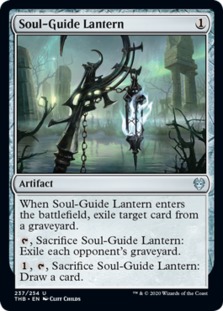Budget Magic: 12-Rare Tempered Steel (Historic)
Om swastyastu, Budget Magic lovers, it's that time once again! This week, we're doing something we've never done before on Budget Magic: playing Historic on Magic Arena! When Historic was first released, the format didn't especially interest me since it was so similar to Standard, but things have changed over the past nine months. Several Historic Anthologies have added new cards to the format, along with a bunch of additional Standard-legal sets, increasing the size of the format. Combine this with other formats being in not-that-amazing of places thanks to companions and broken combo decks, and Historic might be my current favorite format!
Since Historic is currently an Arena-exclusive format, our budget today is a bit different. While our deck is still cheap in paper (around $50) and on Magic Online, my main goal in building the deck was to make it cost as few rare and mythic wildcards as possible to keep the price down on Arena. The end result is what I think might be the best budget Historic deck for ranking up and grinding the ladder: 12-Rare (and 0 mythics) Tempered Steel! How good is Tempered Steel in Historic? Can a 12-rare deck really compete with the top tier of the Historic meta? Let's get to the video and find out; then, we'll talk more about the deck!
Another quick reminder: if you enjoy Budget Magic and the other content on MTGGoldfish, make sure to subscribe to the MTGGoldfish YouTube channel to keep up on all the latest and greatest.
Budget Magic: 12-Rare Tempered Steel

The Deck
Tempered Steel is an artifact-based aggro deck that plays somewhat similarly to Modern Affinity. The idea is to flood the board with cheap (or even free) artifact creatures and then use payoffs like Tempered Steel, Steel Overseer, and All That Glitters to turn those creatures into massive threats and win the game quickly, before the opponent can take over the game with a pile of rares and powerful mythics. The most important part of the deck by far is the payoffs. Most of our random artifact creatures are relatively replaceable—they are in the deck because they don't cost much mana and they are artifacts. So, let's start with our payoffs and then talk about our janky, cheap artifact creatures.
The Payoffs


Our deck has three payoff cards that reward us for flooding the board with cheap artifacts. These cards are essential to the deck's success, to the point where if you don't have at least one in your opening hand, you should mulligan to try to find one (the rest of our cards are really underpowered without the help of a payoff). Our best payoff is our namesake Tempered Steel, a three-mana double anthem for artifact creatures. Our deck is overloaded with one-mana artifact creatures, which means we can often play one on Turn 1 and two more on Turn 2. When we follow up with Tempered Steel on Turn 3, the enchantment immediately adds six power and toughness to the battlefield by pumping our three random artifact one-drops. This allows our deck to get off to incredibly fast starts and run over our opponent with combat damage before they get a chance to stabilize.
Steel Overseer is basically a backup Tempered Steel, tapping to put a +1/+1 counter on all of our artifact creatures. While being a 1/1 creature is a big downside (Steel Overseer tends to die to removal fairly often), if Steel Overseer can stick on the battlefield for a few turns, it can actually be even more powerful than Tempered Steel. Plus, as an artifact creature, Steel Overseer benefits from Tempered Steel, turning it from a 1/1 to a 3/3. If we are worried about removal like Bonecrusher Giant or Shock, it's sometimes better to wait on playing Steel Overseer until after we play Tempered Steel, to boost its toughness out of the range of our opponent's removal.

All That Glitters is our final payoff card, and it's almost the direct opposite of both Tempered Steel and Steel Overseer. Rather than help us go wide by pumping a bunch of creatures a small amount, [[All That Glitters] pumps one creature a huge amount. Since our deck contains 38 artifacts or enchantments, All That Glitters often ends up giving the creature it enchants +5/+5 or even more, which is great for just two mana. It also works really well with some of our cheap artifact creatures that happen to be evasive, like Gingerbrute, Ornithopter, and even Stonecoil Serpent. One of the most common ways we win the game is by forcing through a bunch of damage by going wide with Steel Overseer and / or Tempered Steel over the first three or four turns of the game and then finishing our opponent off with one attack from a single massive creature enchantment with All That Glitters.
The Artifact Dorks
The rest of our deck is filled with cheap (zero- to two-mana) artifact creatures. While all of these cards are slightly different and have different benefits and drawback, from a meta perspective, they are more or less interchangeable in our deck. The point is that we really don't care which of these creatures we have in our hand (at least, most of the time). All we really care about is having a bunch of cheap artifact creatures to benefit from our payoffs.



The best of our cheap artifact dorks are the ones that have some sort of evasion, allowing us to attack our opponent (after growing the dorks with our payoffs) even through blockers. Ornithopter and Gingerbrute are both very difficult for most decks to block, allowing them to hit for huge chunks of damage after Tempered Steel or All That Glitters hits the battlefield. Meanwhile, Stonecoil Serpent is the last rare in our deck. Apart from having a form of evasion (in trample and also protection from multicolored), the biggest benefit of Stonecoil Serpent is flexibility. If we have a Tempered Steel or Steel Overseer on the battlefield, we can cast it as a one-mana 1/1. If we are lacking a payoff, we can spend all of our mana to cast Stonecoil Serpent as a 4/4 or 5/5 and try to use it to close out the game.



Next, we have what I would consider to be our filler artifact creatures. These are cards that are in our deck just because they support our payoffs, not because they are powerful cards in a vacuum. Inquisitive Puppet does offer a bit of value by scrying when it enters the battlefield, which can help us dig for payoffs or push extra lands to the bottom of our deck. Locthwain Gargoyle can actually be pretty powerful in the late game when it can gain flying, but four mana is a lot for our deck (although if we have nothing else going on, it is a way to force through some extra damage). Finally, Sparring Construct can technically grow another creature when it dies, but it's mostly just a 1/1 for one that happens to be an artifact.

Last but not least, we have Voltaic Servant, which is a bit expensive for our deck at two mana (which is why we only have two copies), although it can do some sweet tricks by untapping an artifact on our end step. The most powerful thing Voltaic Servant can do is untap Steel Overseer, allowing us to activate it twice each turn, which quickly grows our team with +1/+1 counters. But even just untapping something like Stonecoil Serpent so we can attack and still have a blocker offers some amount of value.
Other Stuff

Last and probably least, we have two copies of Make a Stand. One of the ways our deck can lose is to our opponent drawing and resolving a wrath on Turn 4. Make a Stand offers protection from cards like Shatter the Sky, Kaya's Wrath, and friends. It can occasionally also be helpful as a backup pump spell on the turn when we are looking to kill our opponent. If we can flood the board with enough cheap creatures, even just +1/+0 can end up being deadly, especially combined with our other payoffs.
The Mana


Our mana is pretty simple: a bunch of Plains and four copies of Zhalfirin Void, as another way to filter through our deck in search of payoffs and to get extra lands out of the way (another way our deck can lose is by flooding out and drawing six or seven lands early in the game—Zhalfirin Void and Inquisitive Puppet help us avoid this fate). I also considered Ghost Quarter for the colorless land slot, but our deck is fast enough that we don't actually care about Field of the Dead ramp decks. In general, we can just race Field of the Dead, and we're likely to lose anyway if our opponent manages to wrath our board, so it doesn't seem worth it, especially compared to the scrying power of Zhalfirin Void.
The Sideboard



Sideboarding with Tempered Steel requires a light touch. In general, I never bring in more than four cards in any given matchup. Voltaic Servant is typically the first card I cut, followed by either Make a Stand (against aggro) or two copies of Ornithopter (against control / midrange). This frees up enough slots to bring in a playset of a removal spell like Glass Casket or Conclave Tribunal, Soul-Guide Lantern against a graveyard deck, or more copies of Make a Stand against wrath decks.
- Conclave Tribunal gives us removal for anything. It mostly comes in against midrange decks and decks built around powerful artifacts / enchantments (like Wilderness Reclamation / Fires of Invention).
- Glass Casket gives us removal for aggressive decks. It comes in against things like Mono-Red Aggro and other decks (like ours) trying to be aggressive with efficient creatures.
- Make a Stand is for wrath matchups, primarily control.
- Soul-Guide Lantern helps against graveyard decks.
- Damping Sphere probably shouldn't be in the sideboard, although I'm not sure what to replace it with.
Wrap-Up

12 Rare Tempered Steel is pretty absurd. As of this article's writing, I've played 15 ranked best-of-three matches with the deck, going 12-3 for an 80% win rate and moving from the middle of Platinum to the middle of Diamond. This is with the same exact build from the video, with no upgrades or changes (even though some changes can make the deck even better). If you're looking to rank up in Historic without spending a lot of wildcards, I'd highly recommend the deck.
If you do decide to pick up the deck, mulliganing aggressively for payoffs is extremely important. Our support cards are not very powerful without the help of Tempered Steel or Steel Overseer (and to a lesser extent, All That Glitters, which is strong but risky as our only payoff, depending on the matchup, since a single removal spell can ruin our day). If you keep a hand of Ornithopters, Gingerbrutes, and Locthwain Gargoyles without a Tempered Steel or Steel Overseer to pump them, you will lose almost every time. Thankfully (or unfortunately, depending on your perspective), the London mulligan rule means we can freely mulligan to six and occasionally five in search of a payoff while still having a functional (and often powerful) hand. If it doesn't have a payoff, don't keep it!
Upgrades and Downgrades
As far as trying to make the deck even cheaper, there isn't a lot to be done. Four copies of Tempered Steel and four copies of Steel Overseer are the heart of the deck—it can't work without them. In theory, you could probably cut Stonecoil Serpent, but there is a problem: we're literally playing every one-drop artifact creature in the Historic format, so cutting Stonecoil Serpent would mean replacing it with a two-drop, which would slow down the deck. In the future, when another artifact one-drop enters the format, Stonecoil Serpent will probably be cuttable (it's very strong in the deck but not essential, like Tempered Steel or Steel Overseer). But for now, I don't think there is a way to get the wildcard cost down below 12 rares.

As far as upgrades, the only main-deck card that 100% should be replaced is Make a Stand, which seems mostly worse than Unbreakable Formation. I would also like to cut Voltaic Servant, but I'm not sure there's a better option available, even though it's the worst card in the deck. I don't believe the deck wants to play a bunch of removal spells or other utility spells in the main deck. Tempered Steel is at its most powerful when every card is a threat, not when we're playing a reactive game of leaving up mana and trying to answer our opponent's creatures. Otherwise, the big changes come to the sideboard, where Grafdigger's Cage gives us an answer to Lukka decks and Winota decks, Thalia, Guardian of Thraben slows down wraths for a turn (which is often all we need to close out the game), and Sorcerous Spyglass gives us a generic answer to things like planeswalkers.
Conclusion
Anyway, that's all for today! What do you think of Historic? Let us know in the comments! As always, leave your thoughts, ideas, opinions, and suggestions and you can reach me on Twitter @SaffronOlive or at SaffronOlive@MTGGoldfish.com.













